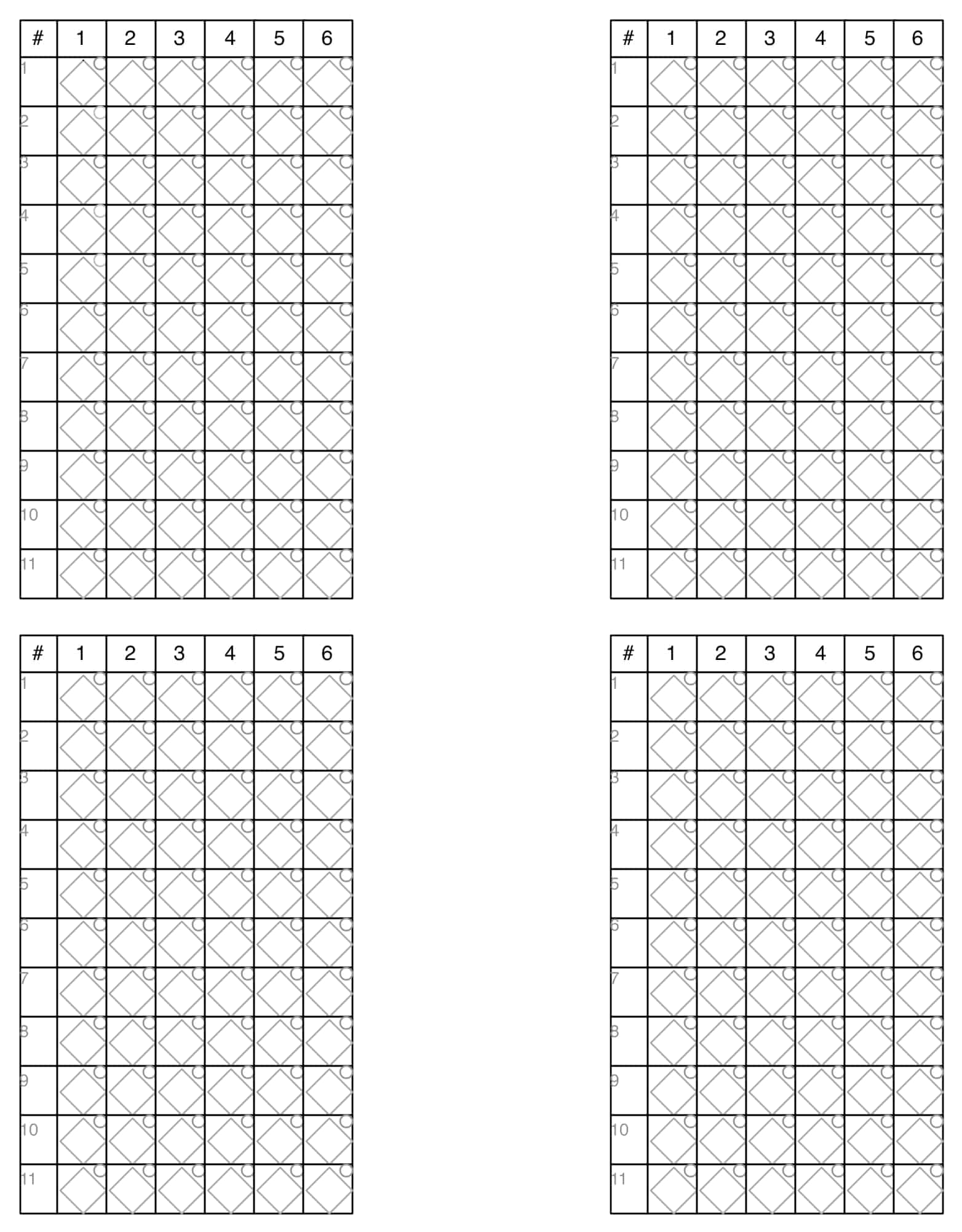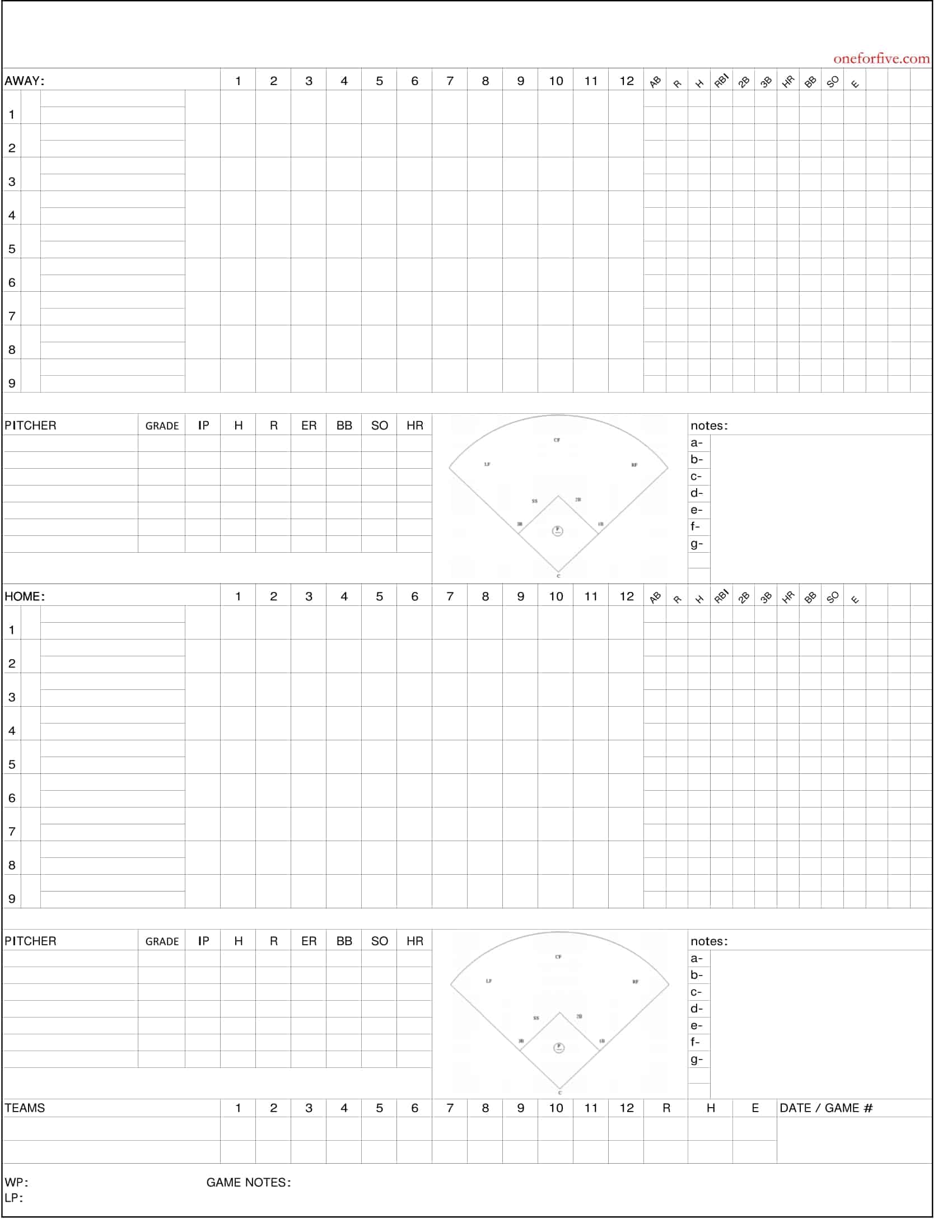Keeping track of the score at a baseball game can be a fun and engaging way to stay invested in the game, whether you’re a player, coach, parent, or simply a fan. Whether you’re keeping score at a Little League game or at a professional game, a baseball score sheet is an essential tool for keeping accurate records of the game’s progress.
This printable baseball score sheet is a simple and effective way to keep track of all the important details of a game, from hitting and fielding statistics to pitching and substitution records. With plenty of space for notes and observations, this template is the perfect tool for coaches, players, and fans alike. So, whether you’re keeping score for an official game or just for your own enjoyment, this printable baseball score sheet is the perfect tool for staying on top of the action.
Table of Contents
Baseball Score Sheet Templates
A baseball score sheet template is a pre-designed document used to keep track of the scores, stats, and other relevant information during a baseball game. These templates can be used by coaches, scorekeepers, or spectators to record the progress of a game and provide a summary of the performance of each player.
Baseball score sheet templates typically include sections for recording the name of the teams, the date and location of the game, the names and positions of the players, and the score for each inning. They may also include space for recording individual player stats such as hits, strikeouts, and RBIs.

The Batting Page
The batting page is a section of the baseball score sheet that is dedicated to tracking the performance of the team at bat. It typically includes columns for the player’s name, position, and plate appearances, as well as rows for each inning of the game.
The batting page usually includes columns for the following statistics:
- At bats (AB): The number of times a player comes to the plate to take a swing.
- Hits (H): The number of times a player gets a base hit.
- Runs (R): The number of runs scored by the player.
- RBIs (Runs Batted In): The number of runs scored as a result of the player’s at-bat.
- Walks (BB): The number of times a player is given a base on balls.
- Strikeouts (K): The number of times a player strikes out.
The batting page also includes columns for tracking other important statistics such as batting average (BA), on-base percentage (OBP), and slugging percentage (SLG). These statistics are calculated using the data entered in the batting page and can provide valuable insights into a player’s performance.
Additionally, the batting page can include columns for tracking advanced statistics such as wOBA, ISO and others, depending on the level of detail needed.
Pitch tracking page
The pitch tracking page is a section of the baseball score sheet that is dedicated to tracking the performance of the pitchers. It typically includes columns for the pitcher’s name, pitches thrown, and results of each pitch.
The pitch tracking page usually includes columns for the following statistics:
- Innings pitched (IP): The number of innings a pitcher pitches in the game.
- Strikeouts (K): The number of times a pitcher strikes out a batter.
- Walks (BB): The number of times a pitcher issues a walk (base on balls).
- Hit By Pitch (HBP): The number of times a pitcher hit a batter with a pitch.
- Runs (R): The number of runs scored by the opposing team while the pitcher is on the mound.
- Earned Runs (ER): The number of runs scored by the opposing team that are earned by the opposing team.
The pitch tracking page also includes columns for tracking other important statistics such as earned run average (ERA) and walks and hits per inning pitched (WHIP). These statistics are calculated using the data entered in the pitch tracking page and can provide valuable insights into a pitcher’s performance.
Additionally, the pitch tracking page can include columns for tracking advanced statistics such as FIP, K/9, BB/9 and others, depending on the level of detail needed.
The Fielding Page
The fielding page is a section of the baseball score sheet that is dedicated to tracking the performance of the players on defense. It typically includes columns for the player’s name, position, and defensive plays made.
The fielding page usually includes columns for the following statistics:
- Putouts (PO): The number of times a player records an out by catching a ball hit in the air or by tagging a runner.
- Assists (A): The number of times a player helps make an out by throwing or relaying the ball to another player.
- Errors (E): The number of times a player makes a mistake that results in an opposing team’s runner being safe or an opposing team’s batter getting on base.
- Total Chances (TC): The total number of plays a player had to make, including putouts, assists and errors.
- Fielding Percentage (FPCT): A statistic that measures the percentage of total chances that a player converts into outs (TPCT = (PO + A) / TC)
The fielding page also includes columns for tracking other important statistics such as range factor (RF) and zone rating (ZR) These statistics are calculated using the data entered in the fielding page and can provide valuable insights into a player’s defensive performance.
Scoring Batting
Scoring batting in baseball involves keeping track of a player’s performance at the plate and recording it on the batting page of a score sheet. The process of scoring batting typically involves recording the following information:
- The player’s name and position
- The number of at bats (AB)
- The number of hits (H)
- The number of runs (R)
- The number of runs batted in (RBI)
- The number of walks (BB)
- The number of strikeouts (K)
Scoring batting also involves calculating certain statistics based on the information recorded, such as:
- Batting average (BA) – calculated by dividing the number of hits by the number of at bats.
- On-base percentage (OBP) – calculated by dividing the number of times on base (H + BB) by the number of plate appearances (AB + BB)
- Slugging percentage (SLG) – calculated by dividing the total number of bases (H + 2B + 3B + HR) by the number of at bats.
Also, scoring batting could include calculating advanced statistics like wOBA, ISO, wRC+ and others, depending on the level of detail needed, these statistics give a more detailed insight on the batter’s performance.
Scoring pitching
Scoring pitching in baseball involves keeping track of a pitcher’s performance on the field and recording it on the pitching page of a score sheet. The process of scoring pitching typically involves recording the following information:
- The pitcher’s name
- The number of innings pitched (IP)
- The number of strikeouts (K)
- The number of walks (BB)
- The number of hit by pitch (HBP)
- The number of runs (R)
- The number of earned runs (ER)
Scoring pitching also involves calculating certain statistics based on the information recorded, such as:
- Earned run average (ERA) – calculated by dividing the number of earned runs by the number of innings pitched, multiplied by 9.
- Walks and hits per inning pitched (WHIP) – calculated by dividing the number of walks and hits allowed by the number of innings pitched.
It’s also, scoring pitching could include calculating advanced statistics like FIP, K/9, BB/9, and others, depending on the level of detail needed, these statistics give a more detailed insight on the pitcher’s performance.
Scoring Fielding
Scoring fielding in baseball involves keeping track of a player’s performance on defense and recording it on the fielding page of a score sheet. The process of scoring fielding typically involves recording the following information:
- The player’s name and position
- The number of putouts (PO)
- The number of assists (A)
- The number of errors (E)
- The total number of chances (TC)
Scoring fielding also involves calculating certain statistics based on the information recorded, such as:
- Fielding Percentage (FPCT) – A statistic that measures the percentage of total chances that a player converts into outs (FPCT = (PO + A) / TC)
- Range Factor (RF) – A statistic that measures the number of plays a player makes per nine innings (RF = (PO + A) / IP)
- Zone rating (ZR) – A statistic that measures the percentage of balls hit into a defensive player’s zone that he successfully fields.
Additionally, scoring fielding could include calculating other advanced statistics like UZR, DRS, and others, depending on the level of detail needed, these statistics give a more detailed insight on the fielder’s performance.
It is important to note that the scoring of fielding should be done for both teams, home and away teams, as the score sheet is used to keep track of both teams’ performance and should be done for every defensive player that appears in the game.
Conclusion
A baseball score sheet is a document used to record the progress of a baseball game as it is played. It is typically used by coaches, players, and official scorekeepers to keep track of runs, hits, errors, and other statistics. It is important for the score sheet to be clear and accurate, as it is used to determine the outcome of the game. Additionally, it is also used to track individual player performance, which can be used for scouting or statistical analysis.
FAQs
How do you make a baseball score sheet?
To make a baseball score sheet, create a table with columns for inning numbers and rows for batters. Add categories for at-bats, hits, runs, RBIs, and defensive plays. Use shorthand like K for strikeouts, BB for walks. Draw diamonds to log where balls are hit. Number defensive player positions. Use directional arrows with shorthand to denote hits. Tally runs by inning in boxes along the side.
What is the simple baseball score keeping app?
Simple apps for baseball scoring include iScore, Ballscore, Scorebook Baseball, Pen and Paper Baseball Scorebook. These allow easy scoring input via scorecard templates and symbols. Many automatically track statistics like pitch counts. They organize player positions andsubstitutions. Data can be shared between devices.
Is there a digital baseball scorebook?
Yes, digital baseball scorebooks replace paper score sheets. Options include apps like iScore, Scorebook XL, Baseball Scorecard. Or use spreadsheet templates designed for scoring. These allow inputting gameplay digitally through typed scoring shorthand, dropdowns and clickable symbols. Many auto-total statistics. Data can be saved, edited, shared digitally.
What does F8 mean in baseball?
F8 stands for a fly ball fielded by the center fielder (position 8) resulting in an out. The F denotes it was caught in the air rather than on a bounce. Standard baseball scorekeeping shorthand logs defensive players by their position number paired with hit types – F8 for a fly out to center field.
































![%100 Free Hoodie Templates [Printable] +PDF 1 Hoodie Template](https://www.typecalendar.com/wp-content/uploads/2023/05/Hoodie-Template-1-150x150.jpg)
![Free Printable Food Diary Templates [Word, Excel, PDF] 2 Food Diary](https://www.typecalendar.com/wp-content/uploads/2023/05/Food-Diary-1-150x150.jpg 150w, https://www.typecalendar.com/wp-content/uploads/2023/05/Food-Diary-1-1200x1200.jpg 1200w)
![Free Printable Roommate Agreement Templates [Word, PDF] 3 Roommate Agreement](https://www.typecalendar.com/wp-content/uploads/2023/06/Roommate-Agreement-150x150.jpg)
